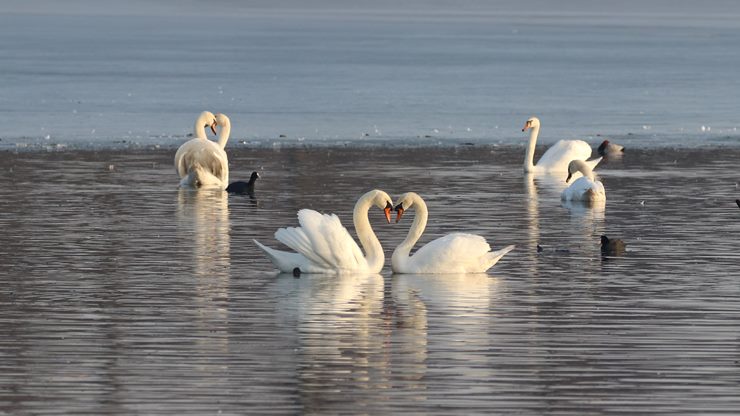Swans are waterfowl with long, gracefully curving necks, recognizable by everyone. These iconic birds are in the same family as ducks and geese. Swans comprise the genus Cygnus, which contains six extant swan species distributed worldwide except in Antarctica.
Table of Contents
Multiple swans often congregate on the water in large, gregarious groups, especially during winter. The collective noun used to describe a group of swans depends on their activity.
A flock of noisy, honking swans swimming in the water is usually called a Bevy or Herd. Swans walking around on shore are called a Bank. When swans are flying in a V-formation, they are called a Wedge or Flight.
Additional collective nouns for groups of swans include:
- Ballet
- Regatta
- Drift
- Royal
- Fanfare
- Whiting
- Sounder
- Swannery
- Mark
- Eyrar
- Squadron
- Lamentation
- Tank
- School
- Tranquility
- Whiteness
- Team
Some collective nouns describe the noise associated with swans, such as fanfare and lamentation. Other nouns relate to their gracefulness on the water, like the nouns ballet and royal.

Where are Swans Found?
The six living swan species found worldwide include the Trumpeter Swan, Black Swan, Black-necked Swan, Mute Swan, Tundra Swan, and Whooper Swan. Mute Swans are from Eurasia but were introduced and naturalized in North America, Australia, and Africa.
Tundra Swans live throughout the Northern Hemisphere, depending on the season. Other swan species have a more localized distribution in different parts of the world. The Trumpeter Swan is the largest in North America. It was almost hunted to extinction but has recovered.
What is a Pair of Swans Called?
Swans mate for life, remaining faithful to their mate throughout their lifespan, which can last up to 24 years in the wild. While swan divorce does occur, it does not happen often. When one mate dies, the remaining bird will look for a new one.
Male swans court the females on the water in an elaborate dance accompanied by honks and hisses. This long courtship and bonding ceremony creates a strong pair bond. The two swans periodically revisit some aspects of the courtship ceremony to strengthen their bond.
A pair of swans does not have a specific name despite their lifelong pair bond. Swans are not sexually mature for two to four years or more after hatching, depending on the species, but they will often bond with a partner before that time.
These swan pairs build a nest together, which can take more than a year. Once the female is mature enough, she will lay a clutch of eggs in the nest. Depending on the species, swan females lay around four to seven eggs.
If the nest fails and does not produce chicks, the pair may separate or “divorce” and mate with other swans.
What is a Group of Baby Swans Called?
After the female swan lays her clutch of eggs, she incubates them in the nest for approximately five to six weeks. The male swan takes turns incubating the eggs with the female. During the nesting and breeding season, swans are more aggressive.
Swans viciously attack anything that might threaten the nest. These attacks can be dangerous for humans and animals like dogs or geese approaching the nest too closely. People should take care to avoid swan nesting areas during this time.
Baby swans are usually called cygnets. They hatch into gray, downy chicks that do not closely resemble an adult swan but are more like the chicks of ducks and geese. As they grow, their necks elongate, and the babies look more like swans than ducks or geese.
Groups of cygnets do not have a specific name. Cygnets imprint on their parents shortly after hatching. The chicks are most vulnerable between hatching and imprinting on their parents. Chicks leave the nest the day after hatching, and parents teach them to swim and feed.
Juvenile swans do not fly until around six months after hatching. Depending on the species, they stay with their parents for up to a year before joining their own flock. They often reside within the bevy until they are mature enough to mate and nest.
Do Swans Flock Together in Groups?
Swans typically spend most of their time flocking on the water, land, or air. Non-breeding swans typically comprise these flocks because they are not territorial or aggressive toward other individuals.
Mated pairs of swans aggressively defend their young from all other animals, including other swans.
During the breeding and nesting season, unmated swans flock together while mated swans stay separate to raise their young. These groups typically occupy different habitats during this time and avoid conflict.
Swans eat a lot of vegetation, with some species consuming more than eight pounds (around four kilograms) daily. Competition for vegetative forage can also cause conflict between swans and other aquatic birds.
During winter, most swans, even mated pairs, typically flock together in the same space. The new juvenile birds have often chosen a new flock to join by winter, so swan parents are less aggressive toward others.
Black Swans typically have larger flocks than other species. Some swan species, like Black Swans, flock together while they undergo their annual molt, which occurs after nesting season. Other swan species molt during incubation instead of in a flock.
Do Swans Migrate?
Some swan species migrate every winter. Tundra Swans that live in the Arctic region migrate south to overwinter in the temperate zones of North America and Eurasia.
The Tundra Swan has two subspecies that spend the summer in different places. The Bewick’s Swan overwinters in southern Europe and Asia, while the Whistling Swan overwinters in southern regions of North America.
Other swan species, except Black Swans, also migrate from the colder parts of their range to warmer, temperate areas during winter. Black Swans also migrate, but they have a more random migration route that follows changes in the climate rather than specific seasons.
